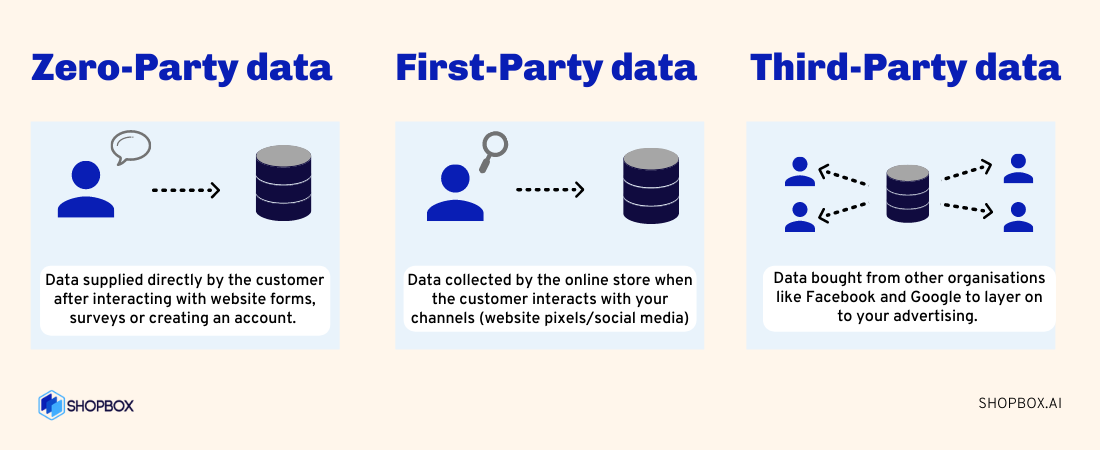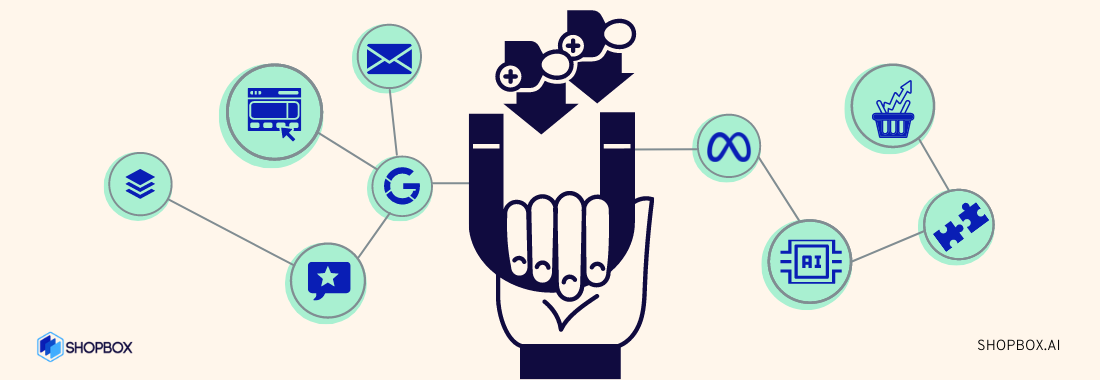So you know the value of first-party data, but do you know how to use it to grow and retain customers? In this blog, we’re going to show you how. But first, let’s unpack and understand first-party data a little more.
What’s the difference between zero-party data, first-party data and third-party data?
Zero party data: Data you asked for
Zero-party data, first coined by Forrester Research and often referred to as ‘explicit data’, is data that a website visitor intentionally and proactively shares with a business, including preference data, purchase intentions, personal context, or information about how they want to be recognised.
Third-party data: Data used to track and follow across the internet
Third-party data, on the other hand, are data sets collected, managed and sold by organisations that do not directly interact with those consumers. This type of data can be collected from a number of different sources to be sold on data marketplaces by data providers or data aggregators. While there are some benefits of third party data, the downside of using this type of data for marketing and advertising purposes is that there’s not always a clear definition of where the audience (and data) comes from, meaning it’s not always entirely accurate in terms of audience type. When it comes to data, reliability is important, especially when marketing budgets are tight, but not only that but also when there are regulations to adhere to.
First-party data: Data to join a customer’s sessions together
That’s why we like the flip side of 3rd party data, which is first-party data and zero-party data – it’s our favourite kind of data. First-party data sets are website visitors’ data sets that a business collects directly from the customer or audience transactions and interactions where their consent is given from a variety of sources from the business.

iOS and Chrome are changing – and it will affect remarketing and online sales
Third-party data was easy but it never helped to build the customer relationship. Instead, Google and Meta built the relationship and sold our own customers back to us. Now you have the chance to do it well and grow a much better business, with higher margins and more repeat customers. The future lies within engagement from the first time they land on your store. It’s an opportunity to build a long term relationship by providing an excellent shopping experience.
Now that the difference is a little clearer, let's unpack why you should be using first-party data to your advantage.
First-party data is the new oil for eCommerce marketers
Getting straight to the point, the reality is that third-party data is dying, if not, already dead. Today, shoppers are much more aware of sharing their information and data, as well as seeing advertising that’s not relevant to them. In fact, when third-party data is used in a way that’s not relevant to the consumer, they could become frustrated by advertising they aren’t interested in at all. At the end of the day, it’s messy, impersonal and irrelevant.
There is also an increasing concern for privacy and customers are much more aware and selective about sharing data. The good part? They are more than happy to share their information if they know they will benefit from it. In fact, according to ZDNet, 4 out of 5 are happy to share their data in exchange for a personalised experience.
With that in mind, here are just a few reasons why it’s time to switch your marketing strategy to using first-party data:
Relevance
Research shows that retargeting with third party data is highly inaccurate. Additionally, it's a terrible experience to be chased around the internet for a product you barely glanced at. Relevance and contextual marketing are the missing pieces of the puzzle, as more and more consumers seek relevant experiences that result in improved targeting and increased ROI for marketers.
Customer retention
Online shopping has become experience-driven, as consumers constantly seek interactive ways of finding what they’re looking for online. Instead of retargeting consumers in an effort to bring them back onto your website, try tactics to keep the consumer on the website the first time, guiding them while they shop until they find what they’re looking for. If the shopping experience was good the first time around, chances are, they’ll be back again. It’s the boomerang effect as Feargal Quinn would have said.
Increased conversion and AOV
Combining relevance with an enhanced shopping experience means less friction and website drop-offs, not to mention it’s an opportunity for consumers to discover more products and stay on the website longer. We all know that equates to more sales.
How to leverage zero-party data and first-party data to increase conversions and revenue
It’s all well and good discussing the benefits of utilising this type of data, but how does one put it into action? Here are a few practical ways to begin.
Make data collection an important part of your growth strategy
It sounds simple, but many retailers and eCommerce marketers often ignore this. When there are tons of marketing campaigns to be done, data collection can fall by the wayside, when in fact, it should be the point at which a brand’s marketing begins.
Integrating zero-party data and a first-party data strategy into your marketing growth strategy will not only help turn website visitors into customers from the first click but will also keep them coming back to your store. The right combination of hyper-personalised experience, psychological cues and an excellent eCommerce stack can help tackle this.

Utilise the power of email marketing
Email marketing is still one of the most powerful and low-cost ways to acquire and retain customers. Put the focus on ways in which you can collect email addresses – thinking about what kind of call-to-action could be included on your website to entice the audience. There are many ways to go about this but for example, it could be in the form of limited-time offers, a new season lookbook or holiday discounts.
The best way to collect email addresses is to convert a prospect into a customer and capture their details along with the sale. Once you have collected your email addresses, it’s time to put a strategy together on how to nurture them into becoming repeat customers with relevant, targeted campaigns and a positive shopping experience.
Create a ‘real-time’ adaptive experience for your website visitors, or fall behind
Technology has changed a lot in the last 4 years and seamless real-time experiences are the norm. So much so that consumers notice when a website isn’t as seamless as they’d hope. AI-Powered experiences are now a part of the most successful and frequently used apps and it’s also the very reason Amazon and Netflix boast such high retention rates.
The good news is that AI and first-party data are best friends, and AI tools can now be seamlessly integrated into your website and CRM, without a hefty price tag. Simply update your CRM system with privacy permissions for all customers and integrate data sources across campaigns. Your website visitors (turned customers) will keep on coming back for a great shopping experience.
Allocate the retargeting budget to customer experience
With third party cookies collapsing, retargeting campaigns are going to have to start looking a little different – and it’s about time. eCommerce marketers have been satisfied with extremely low conversion rates for far too long. With shifting customer expectations, along with rising PPC costs, it’s time for business owners, CMOs and eCommerce marketers to invest in engaging, tailored customer experience.
One of the best parts about reallocating your marketing budget is that when you invest in customer experience, there won’t be much of a need to retarget at all as ROI is much higher with an online store that allows customers to explore and engage. When a visitor lands on your site from an advert or organic search, assisting and curating their shopping experience in real-time will convert them into returning customers.
With the majority of online shopping moving to mobile, mobile functionality is an important factor to consider when it comes to customer experience. When you reduce the need for scrolling, filtering, typing, and more, AI tools like Shopbox can adapt easily to understand the visitor's needs.
Bring the best of the in-store retail experience online with first-party data
Now that you know customer experience is everything, and first-party data is a means to get there, let’s radically improve your customers’ shopping experience with our hyper-personalised AI-powered retail solutions.
We can get Shopbox up and running in your online store as soon as possible – simply get in touch with us today for a demo. We also love to talk retail, technology and customer experience on our blog.

